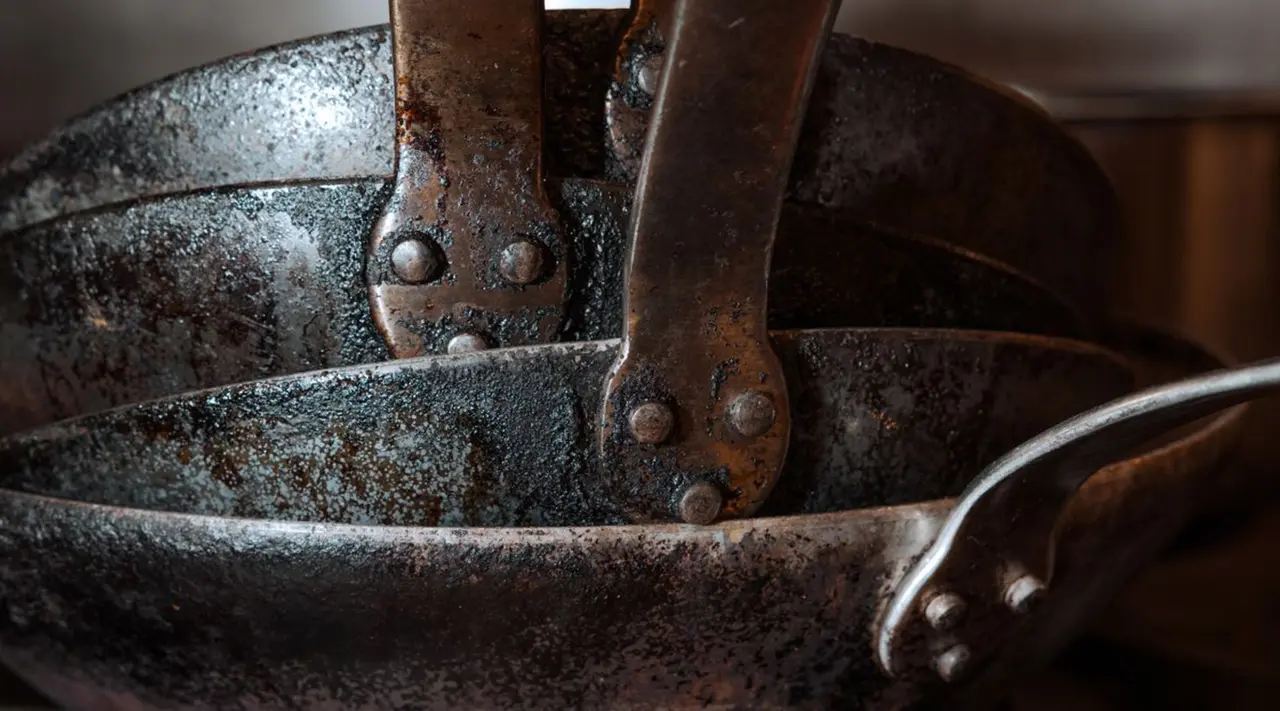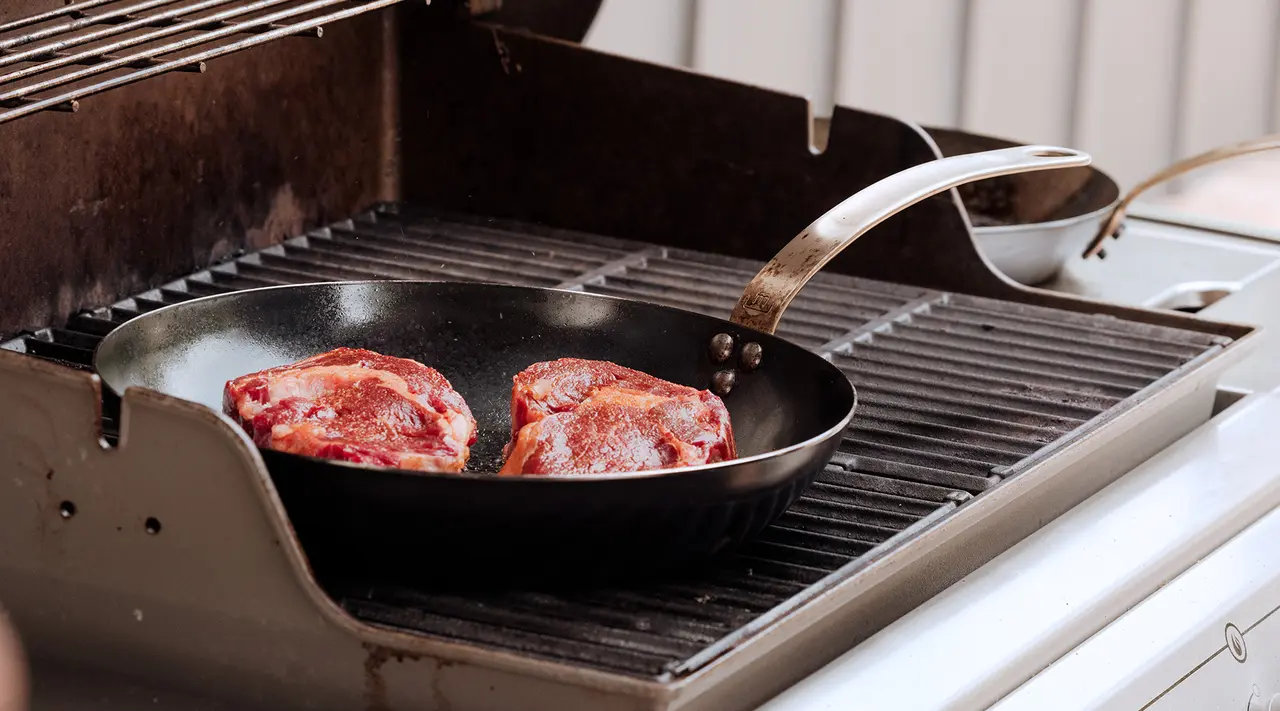As a general rule of thumb, rust and cookware aren't the best combination. That means it's totally normal to do a double take when you first see some appearing on your carbon steel pan. But don't worry: removing a rust stain from a carbon steel pan is easy, and it'll perform just as well (if not better) once you've removed the rust.
With a few tips you'll soon be able to not only clean rust, but prevent it from forming again. Here's how to get your carbon steel cookware looking brand new and rust-free.
Why Does Carbon Steel Rust?

Due to its high iron content, carbon steel is prone to rusting when left in humid or moist environments for an extended period of time. This happens due to the presence of oxidizable iron in the alloy that forms carbon steel (which is what also causes unfinished cast iron to rust).
Most carbon steel cookware users will only have to worry about their cookware rusting in one of two instances:
- Extended exposure to water (i.e. letting it soak overnight — we recommend avoiding this),
- Use in a humid environment or outdoors due to the added moisture in the air. If this applies to you, you’ll need to take some extra precautions to shield your pan from environmental moisture and rust—like seasoning the exterior of your pan to decrease the amount of surface iron.
Already have a rusted area on your pan? Don't panic yet—let’s get into how to remove it with just a little effort and elbow grease.
How to Clean Rusted Carbon Steel

There are a number of ways to remove rust from your carbon steel pan. Below are three of the most popular methods—follow along with our video above or read on for step by step tips.
The Salt Scrub Method
The simplest way to remove rust uses coarse salt and oil to scour surface rust off of a pan.
This method is most commonly used for a small to medium sized bit of rust, but can work on larger rusted areas with a little extra time and elbow grease.
- Pour roughly a 1:1 ratio of coarse salt and a neutral cooking oil (like canola or grapeseed) onto the rust spot.
- Using a circular motion, scrub the salt and oil into the surface of the pan with a paper towel or soft cloth until the rust has been removed.
- Reseason the pan (unless the rust spot was minor, in which case you can clean, dry, and store the pan using the "How to Prevent Rust" method mentioned below).
The Scouring Method
This method involves using a coarse scrubber such as a scouring pad, steel wool, an abrasive sponge, or fine grit sandpaper to forcibly remove rust from your pan’s surface.
This is an effective method for removing rust from anywhere on the pan, including the bottom of the pan—which can sneakily develop rust without you realizing it.
- Using a circular motion, scrub at the rust with your coarse scrubber or steel wool until removed.
- Rinse the pan with hot soapy water.
- Reseason the pan.
Once you have scrubbed and reseasoned your pan, be sure to fully dry your pan with a dry cloth before storing it for your next meal.
The Vinegar Method
For stubborn interior rust that just won’t go away, this method should do the trick and help prevent rust from developing in the future. Note that a reseasoning is all but required after this method, as the acidity of the vinegar will strip away most (if not all) of your pan’s built up seasoning layers.
- Bring equal parts water and white vinegar to a roiling boil in the affected pan over medium heat.
- Carefully pour out the mixture.
- Scrub the pan with an abrasive sponge, soap, and hot water until the rust has been removed, repeating steps 1+2 if necessary.
- Reseason the pan.
How to Prevent Rust from Forming

If your pan isn't rusty quite yet and you're looking to take preventative measures—or want to ensure it doesn't happen again—here's how you can set your pan up to be rust-free.
In addition to following proper carbon steel cleaning protocol and investing in a Carbon Steel Cleaning Kit, we strongly advise doing the following after every cleaning that incorporates water:
- Dry the pan by hand.
- Put the pan on your stove over low heat.
- Dry the pan over the burner until all remaining water has evaporated and the surface is bone-dry.
- Cut the heat, then use a paper towel or dish rag to lightly coat the inside of the hot pan with a very thin layer of a high smoke point oil.
- Allow the pan to cool completely and store.
TL;DR: A protective coating of oil can make all the difference when it comes to preventing stubborn rust.
Why Carbon Steel Should be Reseasoned After Removing Rust
Because removing heavy rust from carbon steel also results in the removal of some (or all) of your pan’s built up seasoning, it’s important to season the pan again afterwards. This ensures the surface of your pan builds up a non stick coating, or patina, over time.
For help getting the seasoning (or reaseasoning) process kickstarted, follow along with our video above.
Ready to Cook?
Now that you're up-to-date on managing rust when or if it develops on your carbon steel pan, there's nothing you can't conquer when it comes to this cookware material. From searing proteins to slow sautés, this versatile material can handle just about anything you throw at it.
























